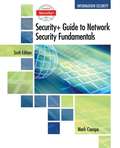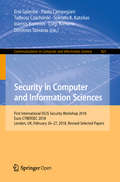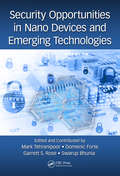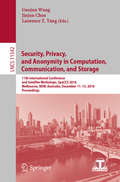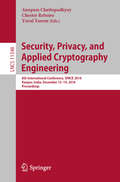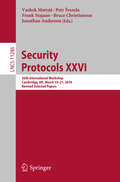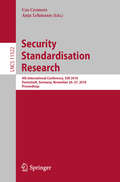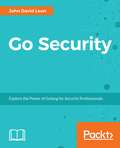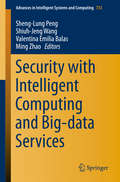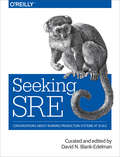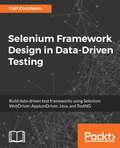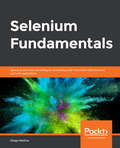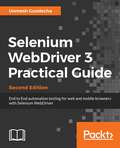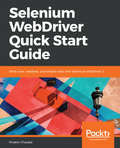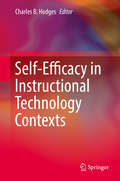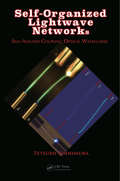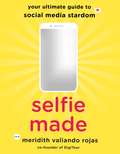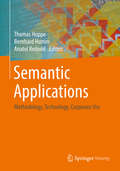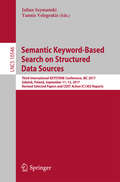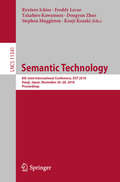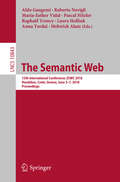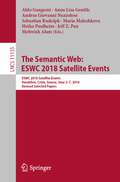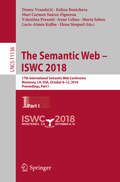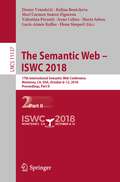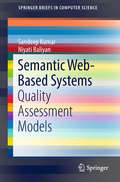- Table View
- List View
Security+ Guide To Network Security Fundamentals (Sixth Edition)
by Mark CiampaComprehensive, practical, and completely up to date, best-selling COMPTIA SECURITY+ GUIDE TO NETWORK SECURITY FUNDAMENTALS, 6e, provides a thorough introduction to network and computer security that prepares you for professional certification and career success. Mapped to the new CompTIA Security+ SY0-501 Certification Exam, the text provides comprehensive coverage of all domain objectives. The sixth edition also includes expansive coverage of embedded device security, attacks and defenses, and the latest developments and trends in information security, including new software tools to assess security.
Security in Computer and Information Sciences: First International ISCIS Security Workshop 2018, Euro-CYBERSEC 2018, London, UK, February 26-27, 2018, Revised Selected Papers (Communications in Computer and Information Science #821)
by Erol Gelenbe Paolo Campegiani Tadeusz Czachórski Sokratis K. Katsikas Ioannis Komnios Luigi Romano Dimitrios TzovarasThis open access book constitutes the thoroughly refereed proceedings of the First International ISCIS Security Workshop 2018, Euro-CYBERSEC 2018, held in London, UK, in February 2018. The 12 full papers presented together with an overview paper were carefully reviewed and selected from 31 submissions. Security of distributed interconnected systems, software systems, and the Internet of Things has become a crucial aspect of the performance of computer systems. The papers deal with these issues, with a specific focus on societally critical systems such as health informatics systems, the Internet of Things, energy systems, digital cities, digital economy, mobile networks, and the underlying physical and network infrastructures.
Security Opportunities in Nano Devices and Emerging Technologies
by Mark Tehranipoor, Domenic Forte, Garrett S. Rose and Swarup BhuniaThe research community lacks both the capability to explain the effectiveness of existing techniques and the metrics to predict the security properties and vulnerabilities of the next generation of nano-devices and systems. This book provides in-depth viewpoints on security issues and explains how nano devices and their unique properties can address the opportunities and challenges of the security community, manufacturers, system integrators, and end users. This book elevates security as a fundamental design parameter, transforming the way new nano-devices are developed. Part 1 focuses on nano devices and building security primitives. Part 2 focuses on emerging technologies and integrations.
Security, Privacy, and Anonymity in Computation, Communication, and Storage: Spaccs 2017 International Workshops, Guangzhou, China, December 12-15, 2017, Proceedings (Lecture Notes in Computer Science #10658)
by Guojun Wang Jinjun Chen Laurence T. YangThis book constitutes the refereed proceedings of the 11th International Conference on Security, Privacy, and Anonymity in Computation, Communication, and Storage. The 45 revised full papers were carefully reviewed and selected from 120 submissions. The papers cover many dimensions including security algorithms and architectures, privacy-aware policies, regulations and techniques, anonymous computation and communication, encompassing fundamental theoretical approaches, practical experimental projects, and commercial application systems for computation, communication and storage.
Security, Privacy, and Applied Cryptography Engineering: 8th International Conference, SPACE 2018, Kanpur, India, December 15-19, 2018, Proceedings (Lecture Notes in Computer Science #11348)
by Anupam Chattopadhyay Chester Rebeiro Yuval YaromThis book constitutes the refereed proceedings of the 8th International Conference on Security, Privacy, and Applied Cryptography Engineering, SPACE 2018, held in Kanpur, India, in December 2018. The 12 full papers presented together with 5 short paper, were carefully reviewed and selected from 34 submissions. This annual event is devoted to various aspects of security, privacy, applied cryptography, and cryptographic engineering. This is indeed a very challenging field, requiring the expertise from diverse domains, ranging from mathematics to solid-state circuit design.
Security Protocols XXVI: 26th International Workshop, Cambridge, UK, March 19–21, 2018, Revised Selected Papers (Lecture Notes in Computer Science #11286)
by Vashek Matyáš Petr Švenda Frank Stajano Bruce Christianson Jonathan AndersonThis book constitutes the thoroughly refereed post-workshop proceedings of the 26th International Workshop on Security Protocols, held in Cambridge, UK, in March 2018. The volume consists of 17 thoroughly revised invited papers presented together with the respective transcripts of discussions. The theme of this year's workshop was fail-safe and fail-deadly concepts in protocol design. The topics covered included failures and attacks; novel protocols; threat models and incentives; cryptomoney; and the interplay of cryptography and dissent.
Security Standardisation Research: 4th International Conference, SSR 2018, Darmstadt, Germany, November 26-27, 2018, Proceedings (Lecture Notes in Computer Science #11322)
by Cas Cremers Anja LehmannThis book constitutes the refereed proceedings of the 4th International Conference on Security Standardisation Research, SSR 2018, held in Darmstadt, Germany, in November 2018.The papers cover a range of topics in the field of security standardisation research, including cryptographic evaluation, standards development, analysis with formal methods, potential future areas of standardisation, and improving existing standards.
Security with Go: Explore the power of Golang to secure host, web, and cloud services
by John Daniel LeonThe first stop for your security needs when using Go, covering host, network, and cloud security for ethical hackers and defense against intrusion Key Features First introduction to Security with Golang Adopting a Blue Team/Red Team approach Take advantage of speed and inherent safety of Golang Works as an introduction to security for Golang developers Works as a guide to Golang security packages for recent Golang beginners Book Description Go is becoming more and more popular as a language for security experts. Its wide use in server and cloud environments, its speed and ease of use, and its evident capabilities for data analysis, have made it a prime choice for developers who need to think about security. Security with Go is the first Golang security book, and it is useful for both blue team and red team applications. With this book, you will learn how to write secure software, monitor your systems, secure your data, attack systems, and extract information. Defensive topics include cryptography, forensics, packet capturing, and building secure web applications. Offensive topics include brute force, port scanning, packet injection, web scraping, social engineering, and post exploitation techniques. What you will learn Learn the basic concepts and principles of secure programming Write secure Golang programs and applications Understand classic patterns of attack Write Golang scripts to defend against network-level attacks Learn how to use Golang security packages Apply and explore cryptographic methods and packages Learn the art of defending against brute force attacks Secure web and cloud applications Who this book is for Security with Go is aimed at developers with basics in Go to the level that they can write their own scripts and small programs without difficulty. Readers should be familiar with security concepts, and familiarity with Python security applications and libraries is an advantage, but not a necessity.
Security with Intelligent Computing and Big-data Services
by Sheng-Lung Peng Shiuh-Jeng Wang Valentina Emilia Balas Ming ZhaoIn the dawning era of Intelligent Computing and Big-data Services, security issues will be an important consideration in promoting these new technologies into the future. This book presents the proceedings of the 2017 International Conference on Security with Intelligent Computing and Big-data Services, the Workshop on Information and Communication Security Science and Engineering, and the Workshop on Security in Forensics, Medical, and Computing Services and Applications. The topics addressed include: Algorithms and Security Analysis, Cryptanalysis and Detection Systems, IoT and E-commerce Applications, Privacy and Cloud Computing, Information Hiding and Secret Sharing, Network Security and Applications, Digital Forensics and Mobile Systems, Public Key Systems and Data Processing, and Blockchain Applications in Technology. The conference is intended to promote healthy exchanges between researchers and industry practitioners regarding advances in the state of art of these security issues. The proceedings not only highlight novel and interesting ideas, but will also stimulate interesting discussions and inspire new research directions.
Seeking SRE: Conversations About Running Production Systems at Scale
by David N. Blank-EdelmanOrganizations big and small have started to realize just how crucial system and application reliability is to their business. They’ve also learned just how difficult it is to maintain that reliability while iterating at the speed demanded by the marketplace. Site Reliability Engineering (SRE) is a proven approach to this challenge.SRE is a large and rich topic to discuss. Google led the way with Site Reliability Engineering, the wildly successful O’Reilly book that described Google’s creation of the discipline and the implementation that’s allowed them to operate at a planetary scale. Inspired by that earlier work, this book explores a very different part of the SRE space. The more than two dozen chapters in Seeking SRE bring you into some of the important conversations going on in the SRE world right now.Listen as engineers and other leaders in the field discuss:Different ways of implementing SRE and SRE principles in a wide variety of settingsHow SRE relates to other approaches such as DevOpsSpecialties on the cutting edge that will soon be commonplace in SREBest practices and technologies that make practicing SRE easierThe important but rarely explored human side of SREDavid N. Blank-Edelman is the book’s curator and editor.
Selenium Framework Design in Data-Driven Testing: Build data-driven test frameworks using Selenium WebDriver, AppiumDriver, Java, and TestNG
by Carl Cocchiaro Pinakin Ashok ChaubalTake a deep dive into building data-driven test frameworks using Selenium WebDriver Key Features A comprehensive guide to designing data-driven test frameworks using the Selenium 3 WebDriver API, AppiumDriver API, Java-Bindings, and TestNG Learn how to use Selenium Page Object Design Patterns and D.R.Y. (Don’t Repeat Yourself) Approaches to software development in automated testing Discover the Selenium Grid Architecture and build your own grid for browser and mobile devices Use third party tools and services like ExtentReports for results processing, reporting, and SauceLabs for cloud-based test services Book Description The Selenium WebDriver 3.x Technology is an open source API available to test both Browser and Mobile applications. It is completely platform independent in that tests built for one browser or mobile device, will also work on all other browsers and mobile devices. Selenium supports all major development languages which allow it to be tied directly into the technology used to develop the applications. This guide will provide a step-by-step approach to designing and building a data-driven test framework using Selenium WebDriver, Java, and TestNG. The book starts off by introducing users to the Selenium Page Object Design Patterns and D.R.Y Approaches to Software Development. In doing so, it covers designing and building a Selenium WebDriver framework that supports both Browser and Mobile Devices. It will lead the user through a journey of architecting their own framework with a scalable driver class, Java utility classes, JSON Data Provider, Data-Driven Test Classes, and support for third party tools and plugins. Users will learn how to design and build a Selenium Grid from scratch to allow the framework to scale and support different browsers, mobile devices, versions, and platforms, and how they can leverage third party grids in the Cloud like SauceLabs. Other topics covered include designing abstract base and sub-classes, inheritance, dual-driver support, parallel testing, testing multi-branded applications, best practices for using locators, and data encapsulation. Finally, you will be presented with a sample fully-functional framework to get them up and running with the Selenium WebDriver for browser testing. By the end of the book, you will be able to design your own automation testing framework and perform data-driven testing with Selenium WebDriver. What you will learn Design the Selenium Driver Class for local, remote, and third party grid support Build Page Object Classes using the Selenium Page Object Model Develop Data-Driven Test Classes using the TestNG framework Encapsulate Data using the JSON Protocol Build a Selenium Grid for RemoteWebDriver Testing Construct Utility Classes for use in Synchronization, File I/O, Reporting and Test Listener Classes Run the sample framework and see the benefits of a live data-driven framework in real-time Who this book is for This book is intended for software quality assurance/testing professionals, software project managers, or software developers with prior experience in using Selenium and Java to test web-based applications.This book is geared towards the quality assurance and development professionals responsible for designing and building enterprise-based testing frameworks.The user should have a working knowledge of the Java, TestNG, and Selenium technologies
Selenium Fundamentals: Speed up your internal testing by automating user interaction with browsers and web applications
by Diego MolinaDiscover how to use Selenium to efficiently test your own applications.Key FeaturesUnderstand the importance of automation with real-world examplesExplore each and every path from configuring an environment to automation with Selenium GridMaster the core concepts of Selenium with 40 exercises and 20 activitiesBook DescriptionThere are several challenges while writing automated tests for web applications: you have to select an adequate test framework, use appropriate selectors to avoid flaky tests, and build a good testing framework. Selenium Fundamentals helps you tackle these challenges and provides you with the knowledge to overcome hurdles in testing by developing stable and effective testing solutions. You’ll learn the complete process of automated testing, such as configuring your environment, creating and running automated tests, analyzing reports, and troubleshooting errors by using a Selenium Grid.To start with, you’ll understand the importance of automating tests. You’ll then move on to understanding how to choose the best selectors for navigating through your web applications while highlighting best practices and techniques.After writing your first tests, you’ll cover the object model to create your own advanced test cases. You’ll analyze a test report, track timing errors, and separate real issues from flaky tests. In addition to this, you’ll learn how to configure and connect to a local grid, a network grid, and a third-party service.By the end of the book, you will have the skills you need to run automated tests on your own web applications.What you will learnGet an overview of SeleniumIdentify what to automate in a project and configure the environmentControl browser behavior and manipulate web page elementsUnderstand the nuances of writing tests and creating test suitesCreate UI tests with Selenium WebDriver and analyze test resultsTroubleshoot errors in automation and build meaningful reportingWho this book is forSelenium Fundamentals is designed for you if you are a software quality assurance and development professional who wants to learn how to automate browser activity and web-based user interface tests with Selenium.
Selenium WebDriver 3 Practical Guide: End-to-end automation testing for web and mobile browsers with Selenium WebDriver, 2nd Edition
by Unmesh Gundecha Satya AvasaralaReal-world examples of cross-browser, mobile, and data-driven testing with all the latest features of Selenium WebDriver 3Key FeaturesUnlock the full potential of Selenium to test your web applicationsUse Selenium Grid for faster, parallel running, and cross-browser testingTest iOS and Android Apps with AppiumBook DescriptionSelenium WebDriver is an open source automation tool implemented through a browser-specific driver, which sends commands to a browser and retrieves results. The latest version of Selenium 3 brings with it a lot of new features that change the way you use and setup Selenium WebDriver. This book covers all those features along with the source code, including a demo website that allows you to work with an HMTL5 application and other examples throughout the book.Selenium WebDriver 3 Practical Guide will walk you through the various APIs of Selenium WebDriver, which are used in automation tests, followed by a discussion of the various WebDriver implementations available. You will learn to strategize and handle rich web UI using advanced WebDriver API along with real-time challenges faced in WebDriver and solutions to handle them. You will discover different types and domains of testing such as cross-browser testing, load testing, and mobile testing with Selenium. Finally, you will also be introduced to data-driven testing using TestNG to create your own automation framework.By the end of this book, you will be able to select any web application and automate it the way you want.What you will learnUnderstand what Selenium 3 is and how is has been improved than its predecessorUse different mobile and desktop browser platforms with Selenium 3Perform advanced actions, such as drag-and-drop and action builders on web pageLearn to use Java 8 API and Selenium 3 togetherExplore remote WebDriver and discover how to use itPerform cross browser and distributed testing with Selenium GridUse Actions API for performing various keyboard and mouse actionsWho this book is forSelenium WebDriver 3 Practical Guide is for software quality assurance/testing professionals, software project managers, or software developers interested in using Selenium for testing their applications. Prior programming experience in Java is necessary.
Selenium WebDriver Quick Start Guide: Write clear, readable, and reliable tests with Selenium WebDriver 3
by Pinakin ChaubalGet writing tests and learn to design your own testing framework with Selenium WebDriver APIKey FeaturesLearn Selenium from the ground upDesign your own testing frameworkCreate reusable functionality in your frameworkBook DescriptionSelenium WebDriver is a platform-independent API for automating the testing of both browser and mobile applications. It is also a core technology in many other browser automation tools, APIs, and frameworks. This book will guide you through the WebDriver APIs that are used in automation tests.Chapter by chapter, we will construct the building blocks of a page object model framework as you learn about the required Java and Selenium methods and terminology.The book starts with an introduction to the same-origin policy, cross-site scripting dangers, and the Document Object Model (DOM). Moving ahead, we'll learn about XPath, which allows us to select items on a page, and how to design a customized XPath. After that, we will be creating singleton patterns and drivers. Then you will learn about synchronization and handling pop-up windows. You will see how to create a factory for browsers and understand command design patterns applicable to this area.At the end of the book, we tie all this together by creating a framework and implementing multi-browser testing with Selenium Grid.What you will learnUnderstand what an XPath is and how to design a customized XPathLearn how to create a Maven project and buildCreate a Singleton driverGet to grips with Jenkins integrationCreate a factory for browsersImplement multi-browser testing with Selenium GridCreate a sample pop-up window and JavaScript alertReport using Extent ReportsWho this book is forThis book is for software testers or developers.
Self-Efficacy in Instructional Technology Contexts
by Charles B. HodgesThis edited volume contains reports of current research, and literature reviews of research, involving self-efficacy in various instructional technology contexts. The chapters represent international perspectives across the broad areas of K- 12 education, higher education, teacher self-efficacy, and learner self-efficacy to capture a diverse cross section of research on these topics. The book includes reviews of existing literature and reports of new research, thus creating a comprehensive resource for researchers and designers interested in this general topic. The book is especially relevant to students and researchers in educational technology, instructional technology, instructional design, learning sciences, and educational psychology.
Self-Organized Lightwave Networks: Self-Aligned Coupling Optical Waveguides
by Tetsuzo YoshimuraThis book gives a solution to the problem of constructing lightwave paths in free spaces by proposing the concept of a Self-Organized Lightwave Network (SOLNET). This concept enables us to form self-aligned coupling optical waveguides automatically. SOLNETs are fabricated by self-focusing of lightwaves in photosensitive media, in which the refractive index increases upon light beam exposure, to realize the following functions: 1) Optical solder: Self-aligned optical couplings between misaligned devices with different core sizes 2) Three-dimensional optical wiring 3) Targeting lightwaves onto specific objects SOLNETs are expected to reduce the efforts to implement lightwaves into electronic systems and allow us to create new architectures, thus reducing costs and energy dissipation and improving overall system performance. SOLNETs are also expected to be applied to a wide range of fields where lightwaves are utilized, for example, solar energy conversion systems and biomedical technologies, especially photo-assisted cancer therapies. Readers will systematically learn concepts and features of SOLNETs, SOLNET performance predicted by computer simulations, experimental demonstrations for the proof of concepts, and expected applications. They will also be prepared for future challenges of the applications. This book is intended to be read by scientists, engineers, and graduate students who study advanced optoelectronic systems such as optical interconnects within computers and optical networking systems, and those who produce new ideas or strategies on lightwave-related subjects.
Selfie Made: Your Ultimate Guide to Social Media Stardom
by Meridith Valiando RojasHOW DO I MAKE IT BIG ON SOCIAL MEDIA? WHAT IS MY STORY—AND WHO IS MY AUDIENCE? WHAT CONTENT SHOULD I POST TO ACHIEVE #SUCCESS? HOW DO I GO VIRAL…OR HOW LONG WILL IT TAKE ME TO GET NOTICED?Selfie Made is a one-of-a-kind guide to creating a digital identity, finding an audience, and building a powerful brand—your own!—on the Internet. Whether you want to be in front of or behind the camera, produce click-worthy content or start your own business, this book is the place to begin. Written by Meridith Valiando Rojas, the hugely successful (and super friendly IRL) founder of DigiTour who has worked with every major star from YouTube to Musical.ly, this collection of personal anecdotes and professional advice, tricks of the trade and behind-the-screen secrets, will give you everything you need for your social media toolkit.Here, you’ll get to know the true stories behind some of today’s most successful multimedia stars and influencers, including:Max And Harvey - Blake Gray - Danielle CohnBryce Xavier - Lauren Godwin - Nathan TriskaTrevor Moran - Messy Monday - Simon Britton…and others who learned the ropes, beat the odds, and took social media by storm. And so can you!
Semantic Applications: Methodology, Technology, Corporate Use
by Thomas Hoppe Bernhard Humm Anatol ReiboldThis book describes methodologies for developing semantic applications. Semantic applications are software applications which explicitly or implicitly use the semantics, i.e. the meaning of a domain terminology, in order to improve usability, correctness, and completeness. An example is semantic search, where synonyms and related terms are used for enriching the results of a simple text-based search. Ontologies, thesauri or controlled vocabularies are the centerpiece of semantic applications. The book includes technological and architectural best practices for corporate use. The authors are experts from industry and academia with experience in developing semantic applications.
Semantic Keyword-Based Search on Structured Data Sources
by Julian Szymański Yannis VelegrakisThis book constitutes the thoroughly refereed post-conference proceedings of the Third COST Action IC1302 International KEYSTONE Conference on Semantic Keyword-Based Search on Structured Data Sources, IKC 2017, held in Gdańsk, Poland, in September 2017.The 13 revised full papers and 5 short papers included in the first part of the book were carefully reviewed and selected from numerous submissions. The second part contains reports that summarize the major activities and achievements that have taken place in the context of the action: the short term scientific missions, the outcome of the summer schools, and the results achieved within the following four work packages: representation of structured data sources; keyword search; user interaction and keyword query interpretation; and research integration, showcases, benchmarks and evaluations. Also included is a short report generated by the chairs of the action. The papers cover a broad range of topics in the area of keyword search combining expertise from many different related fields such as information retrieval, natural language processing, ontology management, indexing, semantic web and linked data.
Semantic Technology: 8th Joint International Conference, JIST 2018, Awaji, Japan, November 26–28, 2018, Proceedings (Lecture Notes in Computer Science #11341)
by Ryutaro Ichise Freddy Lecue Takahiro Kawamura Dongyan Zhao Stephen Muggleton Kouji KozakiThis book constitutes the thoroughly refereed proceedings of the 8th Joint International Semantic Technology Conference, JIST 2018, held in Awaji, Japan, in November 2018. The 23 full papers and 6 short papers presented were carefully reviewed and selected from 75 submissions. They present applications of semantic technologies, theoretical results, new algorithms and tools to facilitate the adoption of semantic technologies and are organized in topical sections on knowledge graphs; data management; question answering and NLP; ontology and reasoning; government open data; and semantic web for life sciences.
The Semantic Web: 15th International Conference, ESWC 2018, Heraklion, Crete, Greece, June 3–7, 2018, Proceedings (Lecture Notes in Computer Science #10843)
by Aldo Gangemi Roberto Navigli Maria-Esther Vidal Pascal Hitzler Raphaël Troncy Laura Hollink Anna Tordai Mehwish AlamThis book constitutes the refereed proceedings of the 15th International Semantic Web Conference, ESWC 2018, held in Heraklion, Crete, Greece.The 48 revised full papers presented were carefully reviewed and selected from 179 submissions. The papers cover a large range of topics such as logical modelling and reasoning, natural language processing, databases and data storage and access, machine learning, distributed systems, information retrieval and data mining, social networks, and Web science and Web engineering.
The Semantic Web: Eswc 2018 Satellite Events, Heraklion, Crete, Greece, June 3-7, 2018, Revised Selected Papers (Lecture Notes in Computer Science #11155)
by Heiko Paulheim Sebastian Rudolph Aldo Gangemi Mehwish Alam Anna Lisa Gentile Andrea Giovanni Nuzzolese Maria Maleshkova Jeff Z PanThis book constitutes the thoroughly refereed post-conference proceedings of the Satellite Events of the 15th Extended Semantic Web Conference, ESWC 2018, held in Heraklion, Crete, Greece, in June 2018.The volume contains 41 poster and demonstration papers, 11 invited workshop papers, and 9 full papers, selected out of a total of 70 submissions. They deal with all areas of semantic web research, semantic technologies on the Web and Linked Data.
The Semantic Web – ISWC 2018: 17th International Semantic Web Conference, Monterey, CA, USA, October 8–12, 2018, Proceedings, Part I (Lecture Notes in Computer Science #11136)
by Denny Vrandečić Kalina Bontcheva Mari Carmen Suárez-Figueroa Valentina Presutti Irene Celino Marta Sabou Lucie-Aimée Kaffee Elena SimperlThe two-volume set LNCS 11136 and 11137 constitutes the refereed proceedings of the 17th International Semantic Web Conference, ISWC 2018, held in Monterey, USA, in October 2018. The ISWC conference is the premier international forum for the Semantic Web / Linked Data Community. The total of 62 full papers included in this volume was selected from 250 submissions. The conference is organized in three tracks: for the Research Track 39 full papers were selected from 164 submissions. The Resource Track contains 17 full papers, selected from 55 submissions; and the In-Use track features 6 full papers which were selected from 31 submissions to this track.
The Semantic Web – ISWC 2018: 17th International Semantic Web Conference, Monterey, CA, USA, October 8–12, 2018, Proceedings, Part II (Lecture Notes in Computer Science #11137)
by Denny Vrandečić Kalina Bontcheva Mari Carmen Suárez-Figueroa Valentina Presutti Irene Celino Marta Sabou Lucie-Aimée Kaffee Elena SimperlThe two-volume set LNCS 11136 and 11137 constitutes the refereed proceedings of the 17th International Semantic Web Conference, ISWC 2018, held in Monterey, USA, in October 2018. The ISWC conference is the premier international forum for the Semantic Web / Linked Data Community. The total of 62 full papers included in this volume was selected from 250 submissions. The conference is organized in three tracks: for the Research Track 39 full papers were selected from 164 submissions. The Resource Track contains 17 full papers, selected from 55 submissions; and the In-Use track features 6 full papers which were selected from 31 submissions to this track.Paper 'The SPAR Ontologies' is available open access under a Creative Commons Attribution 4.0 International License via link.springer.com.
Semantic Web-Based Systems: Quality Assessment Models (SpringerBriefs in Computer Science)
by Sandeep Kumar Niyati BaliyanThe book initially presents the basic concepts related to the Semantic Web, Semantic Web-based applications, Web applications, Ontology, and their qualitative aspects. It then presents the evaluation of the structural quality of modular ontologies and review on metrics for the evaluation of ontology behavior.Further, the book discusses the qualitative evaluation of Semantic Web applications deployed on the Cloud, helping readers understand, maintain, integrate, and reuse these applications. The book offers software engineers in general and ontology engineers in particular a single, valuable guide to help them find the best modularization on the basis of goodness of (re) use. It can also serve as an initial source of information for starting research in this domain.
